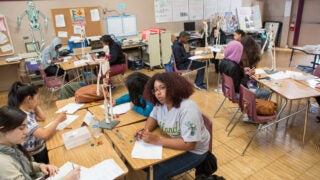Low-cost science kits help African students conduct experiments
USC chemistry student joins an international team that supplies easily shipped equipment for lab work
Having access to basic equipment like test tubes and centrifuges to perform simple science experiments is a given in most American universities. Not so in Africa, where students face a shortage of equipment needed to undertake even basic lab experiments.
Chemistry graduate student Betsy Melenbrink is a member of an international team aiming to help fill the void by building a low-cost electrochemistry device for use in that part of the world.
The group has designed and built a device known as a potentiostat, the hardware used in most electrochemistry experiments. Bright green, small enough to fit in a hand and resembling a video-game controller, it’s now in beta-testing at three East African universities in Malawi, Tanzania and Kenya. A wider rollout is planned later this year.
Funded by a small grant from the Materials Research Society, the teaching lab kit fits into a small cardboard box and can be easily shipped. It includes a potentiostat powered by an Arduino-based microcontroller, plus a lab manual and supplies for a semester’s worth of experiments — assembled for under $100 each. Arduino is an open-source electronics platform.
The inexpensive device can’t match the precision and accuracy of a standard research potentiostat, which runs thousands of dollars, but it’s sufficient for most undergraduate needs, Melenbrink said. The kit that the group has assembled provides hands-on instruction in how energy technologies function — from batteries to solar cells — and reinforces fundamental electrochemistry concepts.
Sustainable energy program
In 2016, Melenbrink learned about an intensive two-week sustainable energy summer program offered by the Joint Undertaking for an African Materials Institute (JUAMI). Founded in 2012 by three professors, the institute is supported by the National Science Foundation. JUAMI sponsors international schools and workshops for young researchers taught by leading materials scientists and engineers, including Sri Narayan, a professor in the Department of Chemistry at the USC Dornsife College of Letters, Arts and Sciences. He also does research at the USC Loker Hydrocarbon Institute.
The opportunity struck a chord with Melenbrink’s strong interest in international education and sustainability.
“JUAMI is geared to get American and African grad students on the same page on sustainable energy research and to establish collaborations,” she said. “I thought it was right up my alley and a potential career direction.”
Melenbrink, a fifth-year PhD student in organic photovoltaics and polymer semiconductor materials research, works in a group that includes Professor Barry Thompson.
Melenbrink applied, was accepted and flew to Tanzania four weeks later to participate in the institute’s summer workshop in Arusha, Tanzania. About 65 graduate students, mostly from East Africa, attended intensive lectures and labs led by teams of African, U.S. and European professors that covered sustainable energy fundamentals such as organic and inorganic photovoltaics, fuel cells and batteries.
The workshop also shed light on the unique challenges facing African students. In much of the continent, and particularly in East Africa, scarce funding and facilities result in an undergraduate science education that emphasizes theory over hands-on learning. A final challenge had participants form teams and submit proposals on the sustainable energy theme.
Many ideas were presented.
“One team proposed something more along the lines of a research collaboration network,” Melenbrink recalled. “One group proposed researching technology to sustainably purify water in Kenyan slums.”
Other groups, including hers, looked at teaching modules. After considering several ideas, they landed on the potentiostat lab.
“We thought it could solve some of the issues brought up in lectures and discussions on problems with undergraduate education and its lack of instrumentation.”
Grassroots funding for science kits
After teams pitched projects in final presentations, everyone returned home and had one month to revise and submit ideas for competitive funding. Seed money was provided by the Materials Research Society, a nonprofit organization of materials researchers, scientists and engineers. Two months later, “Team Potentiostat” got the good news. Their project was among the competing proposals selected to receive $7,500 in seed money to cover materials costs.
For the past year, the team has been working collectively, collaborating via Skype and email to bring its idea to life. The group includes students from five geographically diverse U.S. universities, including Uganda, Kenya, Tanzania. Team member Chris Li from Penn State University built the potentiostat, with the rest of the team contributing software development and experiment design.
Now classroom sets of 10 potentiostats and five experiments are being tested at three partner African universities.
“We’re receiving feedback about how well it works and making improvements,” Melenbrink said. Feedback will guide the project’s expansion to seven additional universities by this fall.
In December 2017, Melenbrink traveled again to Africa to report progress at a Materials Research Society conference in Botswana. NSF funding enabled travel and other funding for both trips. The visit also provided a chance to network and recruit more volunteers and African partners.
It’s very interesting to hear an African perspective from African voices.
Betsy Melenbrink
“It’s very interesting to hear an African perspective from African voices,” she said. “So often we have our Western lens that we see world problems through. It was nice to hear Africans engaging with each other on problems they are encountering and exploring possible solutions.”
A project with potential
Among the 2016 competitors, the potentiostat project was an obvious standout, said Sossina Haile, JUAMI co-founder and materials science professor at Northwestern University.
“I loved the project because I think it has the potential to have the big impact. It’s right at the border of being very cost-effective, yet can do research-level data acquisition.”
Of course, $7,500 in seed funds only goes so far. Haile believes each project’s long-term success requires sustained and persistent student focus and commitment.
“We help birth the chickens, but they have to fly on their own wings,” Haile said.



